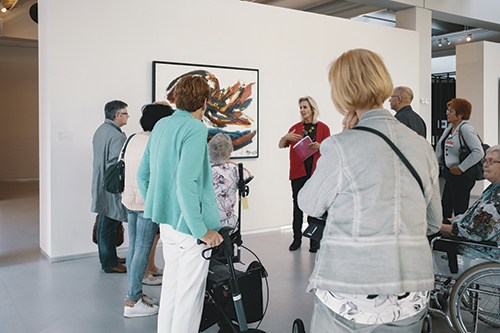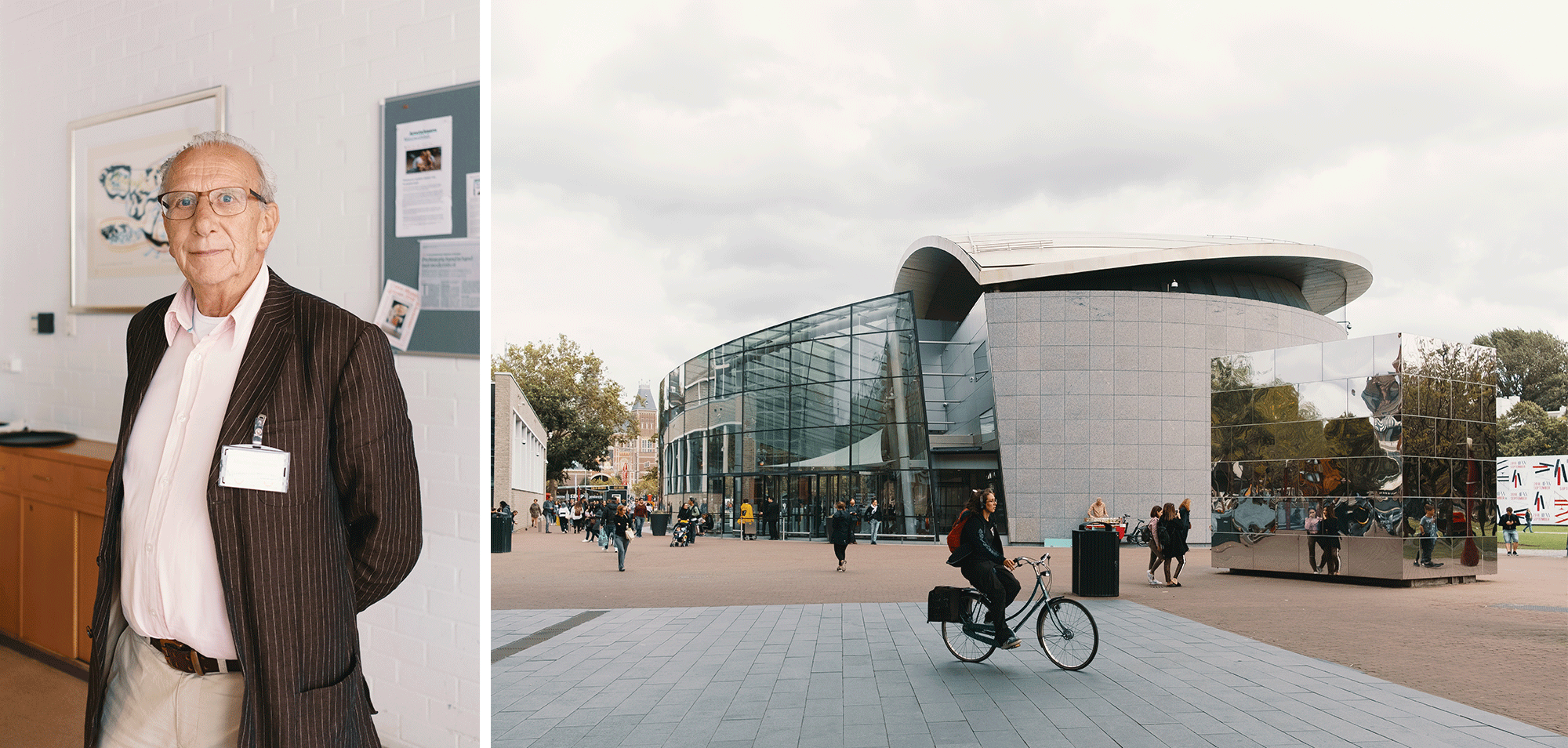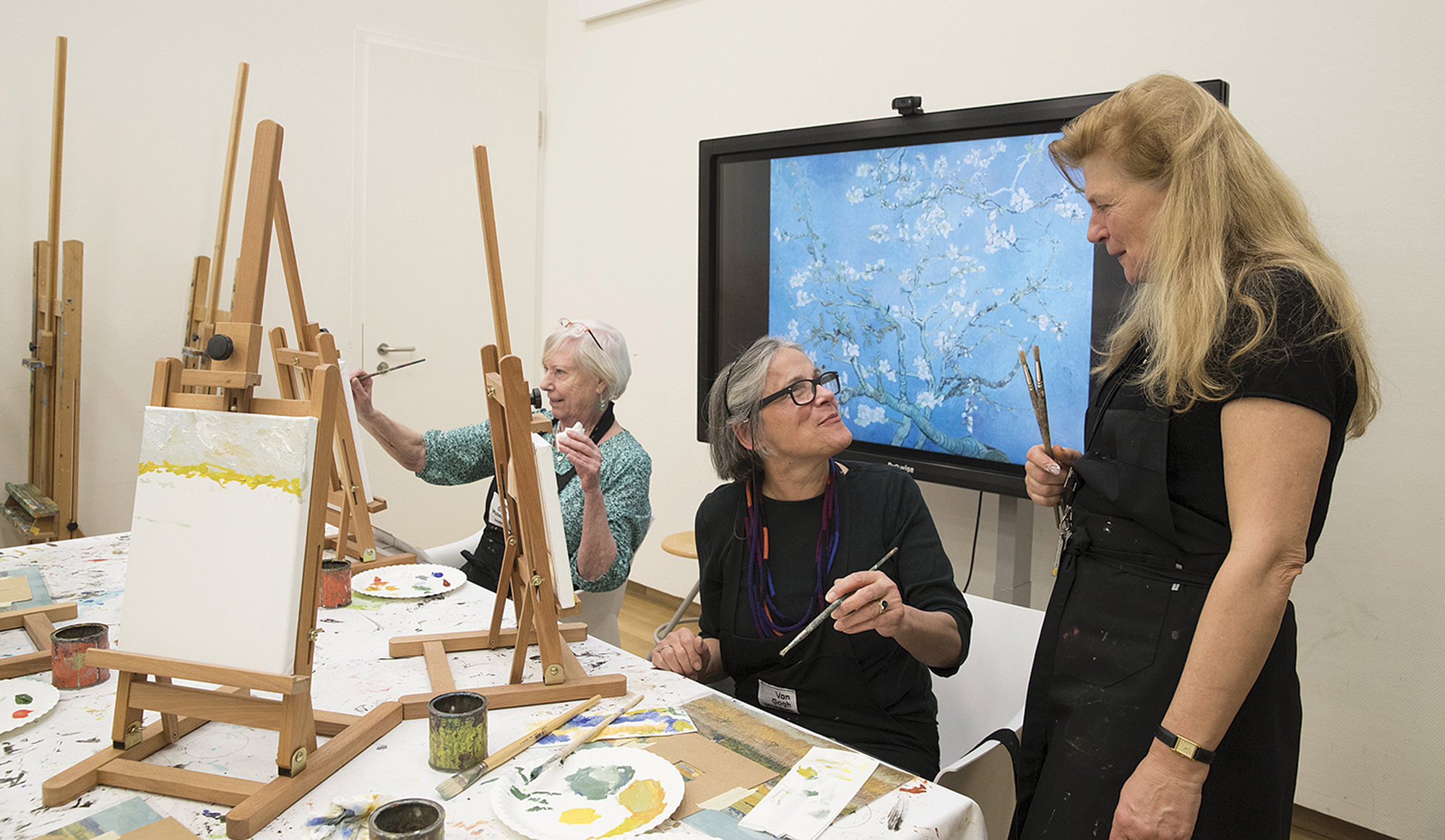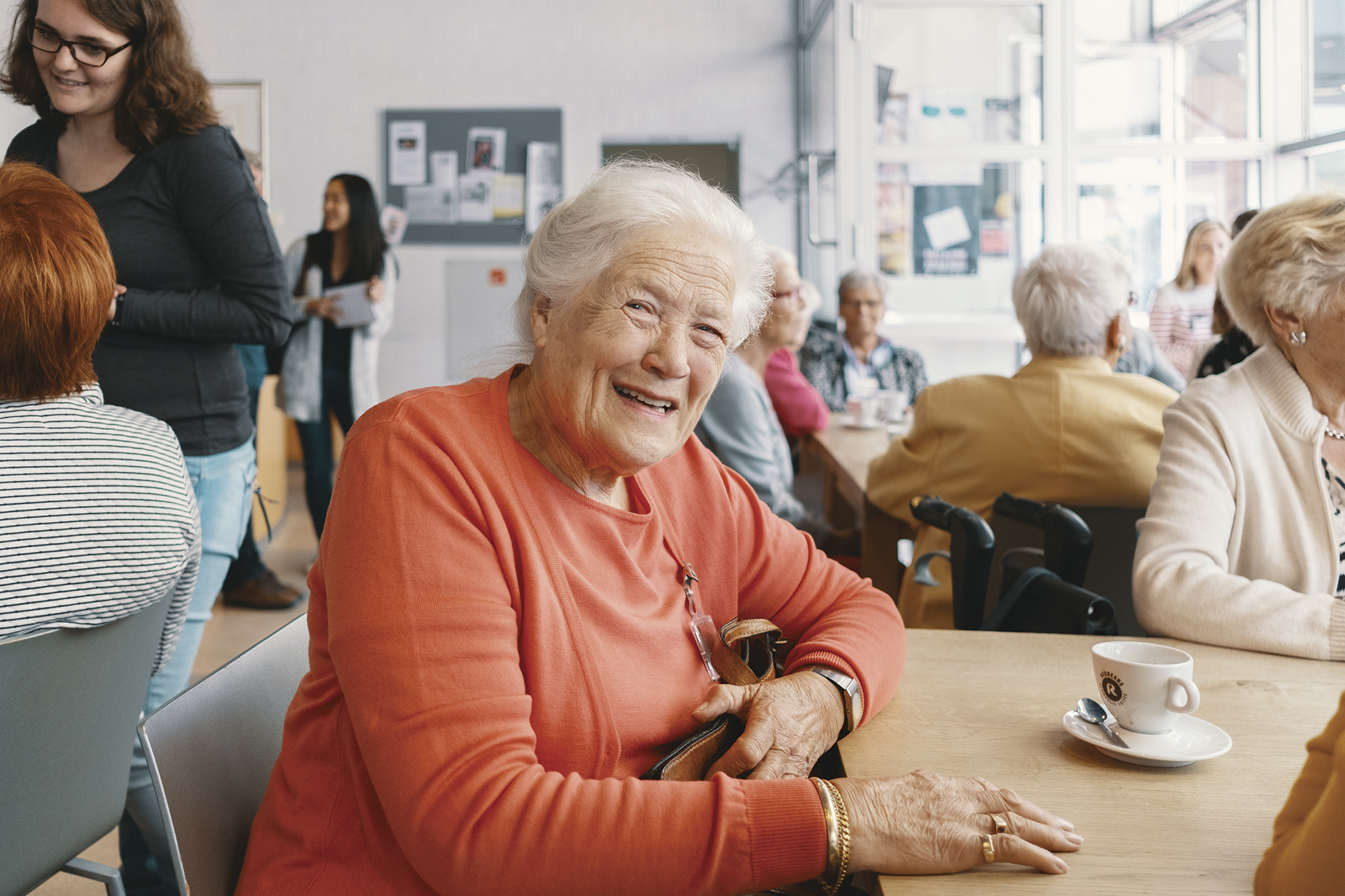- June 05, 2019
- Lauren Hassani
Artful Aging

Adding Meaning to Seniors’ Lives Through Art and Culture
An undercurrent of anticipation surges among the crowd at the Cobra Museum of Modern Art café. Women and men sit at tables in the well-lit, white walled room, sipping cups of coffee and chatting. A smattering of them are in wheelchairs, and many have walkers and canes. The group, all over the age of 65, has traveled for more than two hours by bus to Amstelveen, a southern suburb of Amsterdam, to do what many of them haven’t done in years (and some of them have never done): visit a museum.
Their excursion is proof of a growing nationwide acknowledgment that cultural pursuits like fine art, theater, music, and dance are more than just pleasant distractions for an elite slice of the population. They are a powerful means of engaging older adults from all parts of society and enhancing their quality of life.
The few dozen seniors at the Cobra Museum on this day are here with Museum Plus Bus, an Amsterdam-based organization that arranges free tours for older adults at 14 museums across the Netherlands — from well-known institutions like the Rijksmuseum and the Van Gogh Museum, to lesser-known gems like Kröller-Müller and Cobra. For the past decade, Museum Plus Bus has managed to give thousands of Dutch seniors access to art and culture. With their two massive tour buses, they ferry groups to and from museums about 300 times per year.

Martin Maasland became a Museum Plus Bus tour guide three years ago, after retiring from his career in the publishing industry; the exterior of the Van Gogh Museum, which received 2.26 million visitors in 2017.
A wealth of programs and initiatives like Plus Bus are devising innovative ways to extend the benefits of the arts to the Netherlands’ rapidly graying population. It’s not surprising, given that this is a country with a rich artistic legacy (including Rembrandt, Vermeer, and Van Gogh, to name just a few Dutch icons) and an impressive network of arts organizations. The Netherlands has the fourth highest level of cultural participation in Europe, with 58 percent of citizens actively engaging in cultural activities. Museum Plus Bus is entirely funded by BankGiro Loterij, a national lottery dedicated to supporting causes in the arts. If there’s any indication of the deep appreciation for arts and culture in this country, it’s this; imagine buying a lottery ticket and having fully half of the proceeds go toward funding cultural appreciation efforts. And this being the Netherlands, of course it’s all backed up by research. Ample studies by thorough Dutch academics affirm the theory that cultural participation has a positive effect on the well-being of people of all ages.
In 2013, the national initiative Long Live Arts (Lang Leve Kunst) launched with the specific aim of giving older adults increased access to cultural activities. Leveraging various public-private partnerships, Long Live Arts was able, over three years, to pour about 10 million euros into 950 cultural projects that reached some 400,000 seniors.
For the past decade, Museum Plus Bus has managed to give thousands of Dutch seniors access to art and culture. With their two massive tour buses, they ferry groups to and from museums about 300 times per year.
One of those projects that received funding was a program at the Van Gogh Museum called “Art Makes Man: Older People Meet Van Gogh.” The museum ran a series of popular workshops focusing on the life and art of Vincent Van Gogh that were targeted toward more vulnerable or isolated groups of people age 70 and up. In conjunction with learning about the artist, participants were asked to create their own art, learning how to express themselves and explore a new form of communication.
Since that successful pilot program, the museum has continued its efforts to reach older adults through a more comprehensive age-friendly program. This includes ongoing workshops, as well as visiting days at the museum allotted specifically for older adults and a more accessible, age-friendly building design and visitor experience. To fully understand visits from the seniors’ point of view, staff members were required to undergo a simulation. By wearing restrictive body weights, goggles, and ear plugs, they could detect (and eventually remedy) weaknesses in the design and experience that affected older people, from confusing signage and instructions, to poor lighting, to inadequate elevators. This was all done with the goal of creating a space in which, according to Marthe de Vet, Head of Education and Interpretation at the Van Gogh Museum, “people feel safe enough and free enough to experience the art.”

Seniors in a workshop discuss Van Gogh’s style and learn how to express themselves through art.
As for that art, de Vet believes there’s something special about Van Gogh that is relevant to everyone, but particularly to seniors. Not only is he extremely well known among people of all backgrounds (“He’s like Elvis Presley,” she says, laughing), Van Gogh’s accessible subject matter and his deeply emotional approach to art resonate with them. There’s something so essential and expressive about the thick swirls of yellow and orange paint depicting a simple vase of sunflowers on a table. “And it’s not only his art,” she interjects. “It’s also his life that’s really appealing to people and the issues he is struggling with, which you read in his letters and see in his art about, ‘Who am I?’ ‘What is my meaning to the world around me?,’ and how to deal with illness, loneliness and death.”
As the most visited museum in the Netherlands (and the most appreciated museum in Europe, according to a 2017 Erasmus University study), the Van Gogh Museum might be in the best position to inspire other cultural institutions to create a model age-friendly curriculum and approach. Their team, under de Vet’s direction, is also angling to build an Age-friendly Museum Network similar to one in the U.K. to promote even more collaboration among museums.
One of de Vet’s biggest takeaways from the experience has been the realization that the over-70 crowd is open to learning new things and sitting on a trove of untapped skills and talent. “A lot of elderly people have way more potential than we give them in society. It’s really great to help them to discover what their potential is, who they still are and what they’re still capable of.”
“One of the conclusions was that after these visits, people really say that they have a bigger interest in culture and art,” says van Schaik. “But one of the other finds was that they say they’re less lonely because they’re part of the group.”
Of course, not all of the benefits are quite so profound. One of the main upsides for the seniors is simply getting out of the house and being around people. Project Coordinator Deuwertje Tromp relays some funny feedback from her Museum Plus Bus participants. “We receive many cards and reactions from the seniors and some of them said, ‘Well, being in that bus was amazing.’ That was the highlight.”
Elise van Schaik, also of Museum Plus Bus, says seniors restore old friendships and make new ones during the trips. The excursions always begin with coffee and conversation, which adds to the sense of conviviality and community. Many of the seniors are from small towns and rarely have the chance to venture out. “One of the conclusions was that after these visits, people really say that they have a bigger interest in culture and art,” says van Schaik. “But one of the other finds was that they say they’re less lonely because they’re part of the group.”
At the Cobra Museum on this particular day, the Plus Bus group is getting antsy and eager to take their first peek at the work of Karel Appel, Corneille, Ejler Bille, and Else Alfelt — some of the artists in the avant-garde art movement from which the museum takes its name. CoBrA, derived from COpenhagen, BRussels and Amsterdam, was the first post-WWII collaboration of European artists.

Fanny Laurey, 86, who last visited the Cobra Museum 30 years ago.
Gerda Jagers, 75, wearing comfortable sneakers and accompanied by her walker, confides that this is the first time she has been to a museum since her husband passed away 18 years ago. Fanny Laurey, 86, with white hair and a bright coral sweater, says that she doesn’t normally get out of the house (“at 86, it’s hard to do much”), and is very glad to be on the tour. “But,” she says, leaning in with a conspiratorial whisper, “I don’t prefer modern art.”
Their tour guide (or host, as Plus Bus refers to them), Martin Maasland, 69, has been giving Plus Bus tours for three years now. He wears a brown pinstripe suit jacket and a name tag that indicates he is the one to follow. Maasland says sometimes modern art is tougher to sell to seniors than the work of the old masters, but he encourages them to keep an open mind. “So then they have another look at the object. I think it’s important for them to understand that there are people with another view on the world.” He adds, “You’re never too old to learn.” ◆